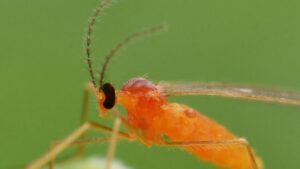
As science makes it possible for growers to have access to better seed and pesticide products, it is the shared responsibility of seed companies and growers to respect and look after new technology or it will be lost. The main purpose of technology use agreements is to ensure environmental and product stewardship.
Mighty Midge
Much excitement is brewing over the development of midge tolerant wheat, which is one of the most helpful technologies to come from the public sector in several years. However, with the discovery of the midge tolerant gene comes responsibility, and SeCan is at the forefront of educating growers on how to grow the wheat successfully and protect the technology to ensure its availability to future generations of wheat growers.
“With midge tolerant wheat, it is about not having to spray,” explains Todd Hyra, SeCan’s business manager. “Money is being saved and beneficial insects are not removed, providing both economic and environmental benefits.” The tolerance is very effective—without some form of resistance management strategy the technology could break down in as little as 10 years, he adds. Therefore, growers are being asked to sign and comply with a stewardship agreement when growing midge tolerant wheat. “Our stewardship agreement says that growers cannot save this seed beyond one year past certified—the goal is to ensure the refuge is maintained to prevent the build up of a resistant pest population,” says Hyra.
Educating Growers is Critical
Growers may find the stewardship requirements and contract governing the use of technology confusing at first. Sometimes they may sign more than one agreement for the same technology. The bottom line is all technology stewardship agreements are designed to protect the longterm viability of the technology being used. However, mechanisms to protect intellectual property also ensure the developer is rewarded for innovations they bring to the market, allowing breeders time to recoup some of the money spent on the research. Hyra explains while all the agreements are similar, the intent may be slightly different. Hence, growers need to be educated by small and large seed companies on the various agreements and encouraged to buy into the process.
“The message we need to impress upon growers is that, ultimately, they are responsible for protection of the technology,” says Stephen Denys, vice-president of sales and marketing at Pride Seeds in Chatham, Ont. A smaller company that doesn’t develop traits of its own, Pride Seeds still recognizes the importance of stewardship and education. “As seed providers … we try to educate our growers,” says Denys. He says Pride Seeds has an agreement growers sign stating they will abide by the conditions of any technology use agreement with the provider of a specific variety, and that they understand their responsibility.
In Eastern Canada, the most important provision of these stewardship agreements are related to either Roundup Ready technology or to access Bt insect protection technology in corn and the resulting refuge requirements. Denys explains that in soybeans there have always been enforcement provisions in place, but until this year there were “no real teeth” in the agreements relating to refuge compliance in corn. Growers would sign the agreements but, with the exception of occasional spot audits, they were not policed regarding compliance. If a grower was found to have less than the required percentage of refuge or no refuge, there were limited consequences. However, that changed last year when the seed industry, working with CropLife Canada, developed a system to audit and address non-compliance. Under the new system, in the case of a first offense, if a grower is found negligent in relation to the agreement, a warning letter will be sent. If there is a second offense, the grower will no longer be able to purchase the trait.
Education is the key to ensuring compliance, according to members of the seed industry and in order to educate, communication must be ongoing. “There is a big education curve,” says Archie Wilson, general manager of C & M Seeds in Palmerston, Ont. “As a seed company, we are bound to protect intellectual property, such as herbicide tolerant varieties, and technology, such as pest tolerance traits, and we need to be sure our customers are aware of the importance of these agreements. It is important they understand that protecting the technology is all part of the value chain. If we lose the technology due to carelessness, the value chain is jeopardized.”
“Farmers need to carefully read the agreements and ensure they understand their role and the requirements,” adds Brent Derkatch of Canterra Seeds in Winnipeg. He says the technologies have helped keep Canada a strong competitor in the global marketplace and that alone should convince growers they need to understand what they are signing because they are agreeing they accept responsibility for protecting the traits.“Sometimes growers are in breach of the agreement out of ignorance rather than intent and that is why it is so important for seed companies to get the attention of their audience and educate them on the importance of protecting the technology.”
As one of the first companies to offer seed technology to Canadian growers, Monsanto has been a leader in developing agreements to protect the technology and their investment. The company set the standard for protecting herbicide tolerant technology, which is now being used to protect trait technology.
“We use a multi-pronged approach in educating farmers and dealers about product stewardship and clear communication is key in everything we do,” explains Chris Anderson, stewardship lead for Monsanto Canada. “For example, each year we send a Technology Use Guide to every grower who uses our technology and it contains guidelines on things like refuge and resistance management. It’s a comprehensive document that answers the questions around stewardship. Most importantly, we also communicate directly with growers to ensure they understand the message.”
Biotech products have altered how farmers manage their farms, Anderson continues. “With the use of the technology comes the responsibility to protect it for the long term,” he adds. “Farmers are good stewards by nature, but everyone also has bills to pay so you have to remind them to always makethe right decisions for the long haul.”
Compliance on some TUAs remains lower than desired—for example for corn refuges it is only about 70 per cent right now and that is not good enough to ensure the technology will have a long life. The industry is hopeful the two strike non-compliance strategy will encourage growers to take their role more seriously, but all seed industry insiders stress that continuing education efforts are key strategies to protect the technology— only education will keep growers an active part of the process. Rosalie I. Tennison













